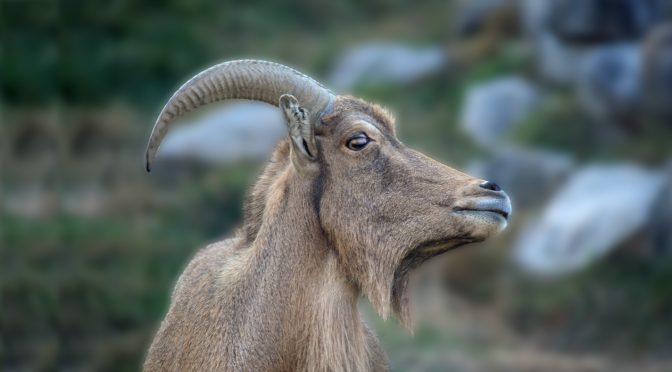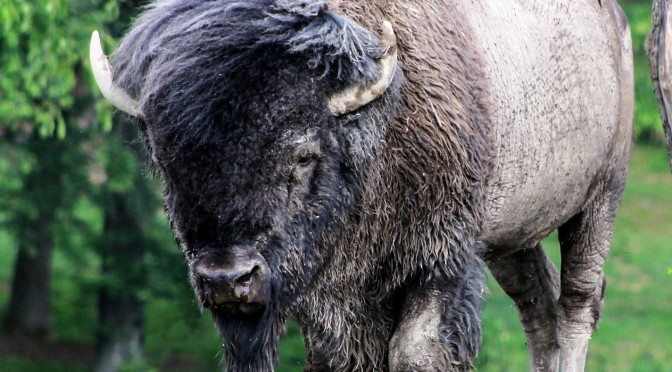
Physical Description
The Amazon tree boa is a more slender snake that can reach lengths of 5-7 feet. They have a wide variety of colors and patterns which can include yellow, gray, red, tan, or black.
Predators
Predators they may encounter include the Harpy eagle and saddleback tamarins.
Lifespan
They live an average of 15-20 years.
Reproduction
This is a solitary species that typically only gets together during the mating season. They are ovoviviparous, which means that the female produces eggs she carries and hatches internally and gives live birth. Their gestation will be 6-8 months with 4-14 snakes being born.
Fun Facts
- The Amazon tree boa is a non-venomous snake but is known for being very aggressive. They will often hang from trees in an S- shape in order to strike at prey.
- They have heat sensing pits on each side of their face that they use to sense heat when hunting at night.
Conservation Messaging
In our Reptile and Amphibian (RAD) center you will find many different reptiles and amphibians including venomous and poisonous species of snakes and frogs. Many of these animals fall victim to habitat loss in the wild. Many of the species here are
found in South American habitats which are subjected to deforestation, damming of rivers, water pollution, and poor agricultural and management practices.

Physical Description
Matamata turtles can grow to be 12-18 inches long and can weigh up to 27 lbs. Their heads and necks are large and flat with many protrusions and skin fringes, and they have fleshy jaws unlike other turtles. The carapace will typically be black or brown with some orange, be bumpy and rough, and have keels running down it.
Predators
This species doesn’t encounter too many predators because of their excellent camouflage and protective shells.
Lifespan
They have an average lifespan of 15 years, though some have been known to live into their 40’s.
Reproduction
Males will court the females by extending their head toward the females and open and close their mouths. The females will build nests near the edge of a forest and lay 12-28 eggs, which will incubate for around 200 days.
Fun Facts
- These turtles are ambush predators that will spend long periods of time camouflaged on bottoms of muddy, slow-moving, shallow bodies of water.
- They use their mouths like a vacuum to quickly suck in any prey that swims by and then expel water in order to just swallow their prey.
Conservation Messaging
In our Reptile and Amphibian (RAD) center you will find many different reptiles and amphibians including venomous and poisonous species of snakes and frogs. Many of these animals fall victim to habitat loss in the wild. Many of the species here are found in South American habitats which are subjected to deforestation, damming of rivers, water pollution, and poor agricultural and management practices.

Physical Description
Leopard Tortoises can grow to be 2 to 2.5 feet long and weigh around 28 lbs, though some have been known to weigh as much as 90 lbs. They get their name from the yellow and black patterns on their shells. These marking are more distinct in younger individuals because they fade as they age.
Predators
Because of their size and protective shell, they do not have many predators as adults. Eggs, however, will be preyed on by a wide variety of smaller predators.
Lifespan
On average, they can live anywhere from 75-100 years.
Reproduction
This species can get very aggressive during mating season when competing for mates. Females will dig a nest and lay 5-30 eggs which will incubate for 240-400 days.
Fun Facts
- The leopard tortoise is the 4th largest species of tortoise in the world and the most widely distributed tortoise in Africa.
- To avoid dehydration and excessive heat, they will burrow underground during hot or dry seasons and stay dormant until the weather improves and the rains return.
Conservation Messaging
The Leopard Tortoise is native to the arid savannas of Central and Southern Africa. While leopard tortoises are considered a species of least concern according to the IUCN Red List, they have been heavily exploited by the pet trade. Leopard tortoises are increasingly being bred in captivity, but many are still taken from the wild to be sold as pets. All animals, even tortoises, play an important role in their ecosystem and one more exotic pet in captivity is one less animal in the wild. The easiest way to ensure we’re not supporting the illegal pet trade is by just saying no to exotic animals as pets.

Physical Description
Spotted turtles are semi-aquatic and grow to be 3-5 inches long. Their carapace is smooth and black with yellow spots. Males will have dark pigment on the hard portions of their jaws, while the females will have yellow coloring on their jaws.
Predators
Some of their most common predators are raccoons and muskrats.
Lifespan
This species has been known to live 30 years or more.
Reproduction
Spotted turtles begin breeding in mid-spring, when the males begin pursuing females. The female will search for a meadow or field to dig her nest where she will lay 3-7 eggs which will hatch in 70-80 days.
Fun Facts
- Hatchlings will only have 1 spot on each scute, while adults will have over 100 spots.
- Temperature during incubation determines what gender hatchlings will be. Warmer temperatures produce females, while cooler temperatures produce males.
Conservation Messaging
In our Reptile and Amphibian (RAD) center you will find many different reptiles and amphibians including venomous and poisonous species of snakes and frogs. Many of these animals fall victim to habitat loss in the wild. Many of the species here are found in South American habitats which are subjected to deforestation, damming of rivers, water pollution, and poor agricultural and management practices.

Physical Description
Hellbenders can grow to be 12-29 inches long and weigh 5-6 lbs. They have a sleek, flattened head and body; short, stout legs, long, rudder-like tails; and loose flaps of skin that run along their sides. Their color varies from grayish-brown to olive-brown, and less commonly black.
Predators
They can be preyed on by raccoons, river otters, fish, turtles, birds, and even larger hellbenders.
Lifespan
In the wild, they live an average of 30-35 years, but in human care they have been known to live 50 years or more.
Reproduction
During late summer and early fall, males will dig a nest under a rock to attract a female who will lay 200-400 eggs. Females will then leave the nest, so sometimes multiple females will lay eggs in the same nest. Males will externally fertilize the eggs and then stay to guard the eggs until they hatch in about 68-75 days.
Fun Facts
- The hellbender is split into 2 subspecies: the Eastern and the Ozark. They are the largest salamanders in North America and are the third largest salamander in the world.
- Hellbenders have lungs, but they use capillaries in the folds of their skin to absorb oxygen from water instead of breathing air. Because of this, it is very important for them to live in clean water.
Conservation Messaging
In our Reptile and Amphibian (RAD) center you will find many different reptiles and amphibians including venomous and poisonous species of snakes and frogs. Many of these animals fall victim to habitat loss in the wild. Many of the species here are found in South American habitats which are subjected to deforestation, damming of rivers, water pollution, and poor agricultural and management practices.

Physical Description
The average height is 2.5-3.5 feet at the shoulder with males weighing around 200 lb and females around 100 lb. Their hooves are designed to be upright on their feet (as if they are walking on their tiptoes). This allows them to travel over rocky and steep surfaces. Some of their most distinctive features include long fringe-type hair from their throat and forequarters as well as horns that are built for ramming.
Predators
In Africa, Aoudad predators include leopards, caracals, and coyotes. In the US, their main predator is mountain lions.
Lifespan
In the wild, Aoudads will live an average of 10 years, but in human care, they can live up to 20 years.
Reproduction
Aoudads have small family groups. The gestation period is approximately 5-6 months. They may give birth to 1 or 2 lambs in March through May.
Fun Facts
- Wild populations are decreasing because of habitat loss and hunting. For the people of the Sahara, the Aoudad has served as an important meat source as well as being used for their hide, hair, and sinew.
- They will often take refuge on steep slopes to avoid human disturbance or predation. Thankfully, they are excellent climbers and jumpers.
Conservation Messaging
As an Association of Zoos and Aquariums (AZA) accredited facility, the Lehigh Valley Zoo is proud to play a role in the conservation community through participation in Species Survival Plans, or SSPs. This means our Kordofan Aoudad are part of a breeding program where we help to maintain captive populations that are both genetically diverse and demographically stable.
By visiting the Lehigh Valley Zoo and other AZA member institutions, you’re supporting the highest level of animal care and welfare, along with the promotion of conservation of animals such as the Kordofan Aoudad.

Physical Description
A mature bull can reach 5.5-6.5 feet high at the hump and 9-12.5 feet in length, while females are normally smaller, only reaching 5 feet high. Bison have a large hump over the front shoulders and slimmer hindquarters. Both male and female bison have a single set of short, sharply pointed, hollow horns that curve outward and up. Heavy coats are shed in the spring as the animals roll to loosen the hair, which falls off in gobs.
Predators
Because of their size and powerful bodies, bison do not have many predators. However, sick, injured, or elderly individuals may be preyed on by mountain lions, bears, or wolves.
Lifespan
Their average lifespan is 15-20 years.
Reproduction
Bison are usually found in bands arranged by sex, age, season, and habitat. Males will protect their mate during the breeding season and will often lose 200 lbs or more during this time. The breeding season usually lasts from June to September with a gestation period of approximately 285 days. Females give birth to 1 calf away from the herd and will nurse them for 7-8 months before weaning them at about 1 year old.
Fun Facts
- The North American Bison is split into two groups: the Plains Bison and the Wood Bison. Bison were once widespread and found from Alaska to northern Mexico, but the current range occupied by conservation herds has diminished to one percent of its original status.
- Bison are the largest terrestrial animal in North America and can weigh between 1,800 to 2,400 pounds.
Conservation Messaging
Bison were once widespread and found from Alaska to northern Mexico, but the current range occupied by conservation herds has diminished to one percent of its original status. One thing that we can do is support sustainable agriculture practices. By purchasing products that are certified by organizations such as the Rainforest Alliance and Bird Friendly, you are helping in the conservation of forests and habitats around the world.

Physical Description
The Black Swan has dark, black body plumage with white feather tips on its wings. They have an average wingspan of 5-6.5 feet and will weigh around 13-20 lbs. Black Swans have the longest neck to body ratio of any swan species. Their beak is deep red with white band at the tip, and they have black, webbed feet.
Predators
Black Swans have no natural predators, but they may be preyed on by introduced species such as cats, dogs, and foxes.
Lifespan
In the wild, they live an average of 12 years, but in human care, they have been known to live up to 40 years.
Reproduction
Adults will typically mate for life. Their breeding season lasts from February to September. Both parents will help build the nest where the female will lay 5-8 eggs. The pair will alternate incubating the eggs for a period of 35-40 days.
Fun Facts
- Swans molt once a year during which time they are flightless.
- Although they are only native only to Australia, black swans have been introduced all over the world, including in Europe, North America, and New Zealand.
Conservation Messaging
Here at our duck pond, we welcome all species of native migratory birds. You can see different species of ducks and waterfowl as they migrate with the seasons. Our resident waterfowl have learned to coexist and share their habitat with these birds because they serve them a purpose. As with most birds, these migratory species are excellent at seed dispersal allowing a diverse plant community to form within their habitat as well as many other habitats.

Physical Description
Chuckwallas are typically 15 inches long with half of that body length being their tail. Their color will depend on temperature, geographic location, surroundings, and mood. Males are usually larger and may be more rust colored with black limbs, while females may be more gray-yellow in color.
Predators
Some predators they may encounter include rattlesnakes, coyotes, kestrels, and red-tailed hawks.
Lifespan
Their average lifespan is 25 years, though some have been known to live up to 65 years.
Reproduction
Breeding occurs from April to July with eggs being laid from June to August. Females will lay 5-16 eggs which will hatch in late September.
Fun Facts
- When threatened, they will wedge themselves into rock crevices, expand their lungs to increase their body mass, and use their scales to catch on rocks so that predators have a difficult time removing them.
- Chuckwalla can withstand basking temperatures of up to 100-105 degrees Fahrenheit.
Conservation Messaging
In our Reptile and Amphibian (RAD) center you will find many different reptiles and amphibians including venomous and poisonous species of snakes and frogs. Many of these animals fall victim to habitat loss in the wild. Many of the species here are found in South American habitats which are subjected to deforestation, damming of rivers, water pollution, and poor agricultural and management practices.

Physical Description
White Cockatoos, also called the Umbrella Cockatoos, are known for their distinct white feathers and their broad, backward-bending crest, which opens like an umbrella and fans out. They can use these crest feathers to communicate with each other. Their average wingspan is 9-12 inches.
Predators
They can be preyed on by birds of prey, snakes, and cats.
Lifespan
Cockatoos can live 60 years or more, but some in human care have been known to live over 100 years!
Reproduction
Both parents will help incubate the eggs. Once hatched, the parents will typically only care for the healthier chick. Chicks will learn to fly by the time they are 3 months old, but they will still be dependent on their parents for another 2-3 weeks after that.
Fun Facts
- Cockatoos are known to be intelligent and have even been seen using branches as tools!
- They have a beak that is strong enough to break a human finger!
Conservation Messaging
Lorikeets and Cockatoos are often viewed as these beautiful and intelligent birds. While many people will fall in love with exotic birds for that reason, most of these birds are considered vulnerable, threatened, or endangered out in the wild.
By purchasing and owning an exotic animal, you could be supporting the illegal exotic pet trade. What we see is vibrant colors of a parrot or the incredible ability to mimic sound but what we don’t see is how these animals were first illegally poached from the wild. One more exotic pet in captivity is one less animal in the wild which is resulting in species population numbers dropping drastically.











